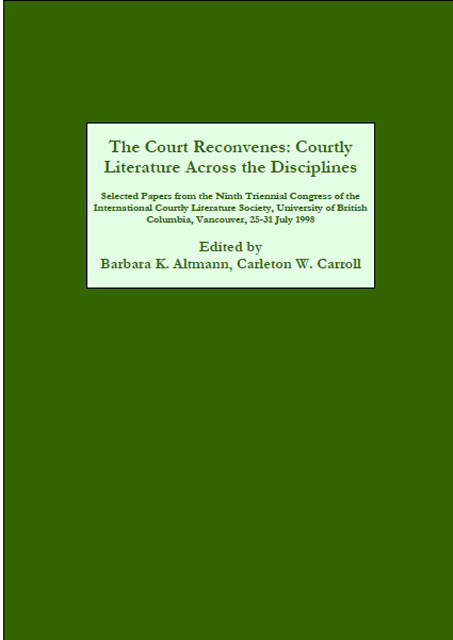 The Court Reconvenes
The Court Reconvenes Tracking the Anagram: Preparing a Phonetic Blueprint of Troubadour Poetry
Published online by Cambridge University Press: 31 March 2023
Summary
Much scholarly effort has gone into the study of the anagram (Jakobson, Kristeva, Wunderli), prompted by the writings of Saussure and following the 1971 publication of an (incomplete) edition of Saussure's notebooks by Starobinski. The difficulty has always been to furnish “proof “ – Saussure himself wondered if he were dealing with simple fortuitous coincidences (Jakobson 22). The challenge is to develop a reliable analytical approach permitting researchers to establish the presence of minimal phonemic units capable of operating in anagrammic procedures. In this article, we will present a computer-aided method of analysis (using the text retrieval program TACT) applied to a body of troubadour songs for the purpose of generating a classification of their phonetic content. The “phonetic blueprints” thus identified are used as a norm against which to measure the phonetic profiles of individual songs, leading to the detection of phonemic “agendas” the poets might be exploring. The results will be exemplified in the form of two brief analyses.
The Hypophone
Before we discuss corpus and methodology, we first need to define our terms. For the purpose of this paper, we will adopt Meylakh's definition of the anagram: ”… the phonetic structure of certain key-words, whose semantic contribution in the text is reinforced and valorised throughout the composition by the presence of phonemic fragments of these key-words” (149). What is described here is the non-linear anagram: the scattering, throughout a line of text, of the phonemes of a key word. Saussure and others have used a bewildering array of terms to describe phenomena related to the anagram, such as “paragrams,” “hypograms,” “cryptograms,” and “syllabograms.” Clearly, the common feature in all these terms is the suffix -gram: something that is written. But since the troubadour songs were meant to be heard rather than read, the use of the suffix -phone would appear to be more appropriate than -gram. It may be argued that the presence of anagrams in a text constitutes an added value over and above the meaning conveyed by the linear text and that for that reason, the term hyperphone would be more suitable. However, we elected to adopt the term hypophone, as it aptly expresses the idea of a subliminal meaning hidden below the surface of the linear text.
- Type
- Chapter
- Information
- The Court ReconvenesCourtly Literature across the Disciplines: Selected Papers from the Ninth Triennial Congress of the International Courtly Literature Society, University of British Columbia, Vancouver, 25-31 July 1998, pp. 199 - 214Publisher: Boydell & BrewerPrint publication year: 2002
- 1
- Cited by


